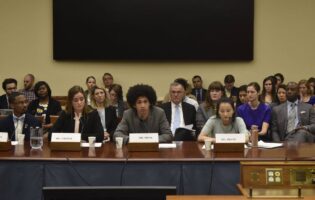
Michael Panse via Flickr
The Role of Fertility and Family Leave Policies in Shaping Fertility and Female Labor Supply: A Comparative Perspective

Hanna Wang
University of Pennsylvania
Hanna Wang was a DAAD/AICGS Research Fellow for June and July 2018. She is currently a doctoral student in Economics at the University of Pennsylvania. Her research interests include Labor Economics, Family Economics, and Search and Matching.
During her time at AICGS, Ms. Wang will be working on her dissertation studying the effects of family policies on women's work and childbearing decisions in Germany. In the recent decades there have been many changes in family policies such as paid parental leave, childcare subsidies, and per-child subsidies in OECD countries including Germany, the U.S., and other European countries. These reforms respond to concerns about falling birth rates, low maternal employment, and large gender gaps in wages. Women bear the burden of childbirth and most of childrearing, which prove as significant obstacles for their careers. Not only do they lose wages when taking time off work, they also forgo work experience which is necessary to increase future wages. With women investing more in education and playing an increasingly important part in the overall workforce, family policies that promote women's careers could provide a significant boost for the economy. Furthermore by reconciling family and work, family policies encourage women, particularly those with higher levels of education, to have more children. This is beneficial for sustaining social security systems, in which older generations depend on tax payments of younger ones. In her dissertation, Ms. Wang aims to investigate which policy packages are most effective at achieving a set of goals relevant to most OECD countries.
Raising fertility and female employment levels constitute primary concerns for policymakers in the developed world. Childcare subsidies, paid and unpaid parental leave, and direct per-child subsidies, often referred to as family policies, are common tools used for these purposes. These policies provide financial support and job protection to households with children: Childcare subsidies defray a portion of the childcare costs for working parents, paid parental leave helps stay-at-home parents to maintain their previous consumption levels, and unpaid leave allows parents to return to their previous employment. Per-child subsidies are transfers to parents of underage children (in some countries, like Germany, adult children without an income also receive payments until the age of 25) and can be in the form of fixed payments or income tax deductions. Any policies that target fertility or female labor supply inevitably interfere with each other to some degree due to the dynamic interdependence of the two choices. In addition, because family policies are often tied to conditions on income and parental employment, they can have opposing effects on work incentives. For instance, increasing childcare subsidies for children of a certain age mitigates the employment-reducing effects of paid parental leave that is warranted during the same age period. Nearly all developed countries have a combination of different policies in place. It is therefore crucial for policymakers to carefully consider the joint effects and possible interactions.
Because family policies are often tied to conditions on income and parental employment, they can have opposing effects on work incentives.
The majority of OECD countries have been experiencing low fertility rates well below the replacement rate. On average women have about 1.5 children; however, 2.1 children are needed to sustain constant population size. In some countries such as Italy, Japan, and Germany, the problem is particularly severe with each woman only giving birth to about 1.4 children. The U.S. used to consistently have fertility rates close to replacement but saw a decline of about 0.2 after the Great Recession from which there has been no recovery yet. It is well documented that fertility tends to decline with higher wealth levels, but low fertility is not limited to developed nations. With progressing economic growth worldwide, fertility has dropped below replacement for some developing countries. One important example is China, which, after pursuing a one-child policy for more than three decades, is now faced with a low number of births of only about 1.6 children per woman according to World Bank data from 2016. Birth rates even failed to increase substantially after a new two-child policy reform was implemented in 2015, prompting discussions of further pro-fertility state subsidies (according to state-owned newspaper ChinaDaily.com.cn, government officials are considering “birth rewards and subsidies”).
Low fertility shrinks the workforce and, together with a rise in life expectancy, puts a strain on the social infrastructure to support a growing number of retirees. In addition to encouraging births, policymakers can increase female employment as part of the solution. However, because women incur large career costs when having children, it is difficult to achieve both simultaneously. Women are typically the ones taking on childcare responsibilities and reducing work hours, which leads to a decline in human capital and wage growth. As a large body of research established, this is the primary cause of substantial gender wage gaps across all countries. In contrast, childless women have very similar employment and wage levels to those of men. Furthermore, there is global evidence that fertility is negatively correlated with women’s level of education. For instance, in the U.S., women with a bachelor’s degree had 0.18 fewer and women with a graduate degree 0.26 fewer children than the national average in 2012, as shown in a fertility report by the U.S. Census Bureau. This exacerbates imbalances in childrearing resources and inter-generational wealth transfers. The reason for this is two-fold. More highly educated women earn higher wages and therefore forgo more income when reducing labor supply for children. Moreover, they tend to face a steeper decline in wage growth due to working in occupations in which work experience depreciates faster.
Low fertility shrinks the workforce and, together with a rise in life expectancy, puts a strain on the social infrastructure to support a growing number of retirees.
Hence, in addition to increasing overall fertility there is a particular interest in alleviating the burden on women’s careers to promote higher maternal employment and induce women with higher levels of education to have more children. This is part of the reason why for the recent two decades many countries spent millions of dollars, if not billions, to increase the generosity of policies which specifically target working women and mothers. These are first and foremost parental leave and childcare policies. Several U.S. states, including New York and Washington, recently passed laws for paid parental leave, which does not exist on a federal level but has been the subject of discussion for many years. In the summer of 2018, Senator Marco Rubio introduced the Economic Security Act for New Parents which stipulates that parents can access retirement funds early to cover the leave period. Many European countries such as Denmark, Portugal, or Poland as well as Asian countries like Japan and South Korea increased the length of paid and unpaid leave as well as the pay amount in a series of reforms. The province of Quebec in Canada implemented universal childcare in the years 1997-2000. Sweden capped childcare prices in 2002 thereby significantly reducing costs for higher income families and the UK has gradually increased publicly funded childcare for three to four-year-olds since 2010.
An exemplary case is the German one. Germany’s low fertility rate, high female part-time rate, and high childlessness rate have fueled a heated public debate about women’s fear of being trapped in traditional gender roles once they become mothers. In fact, the vast majority of German fathers work full-time, while childcare falls to the mothers. As a result, two large recent reforms were implemented: a parental leave reform in 2007 which increased the average pay to parents while simultaneously shortening the eligible period from two years to one year, and gradual expansion of low-cost public childcare since 2005, with a focus on young children below the age of three. These policies reflect the new objectives to reconcile family and career for women. In contrast, the previous set of parental leave, childcare, and fixed child subsidies had the role of guaranteeing a minimum income for families with children and reducing poverty.
Germany’s low fertility rate, high female part-time rate, and high childlessness rate have fueled a heated public debate about women’s fear of being trapped in traditional gender roles once they become mothers.
The economic literature usually investigates the effects of family policy reforms comparing outcomes before and after reforms. Typically, the findings are small to moderate effects on employment and modest effects on fertility in the short and medium term. For instance, Lefebre and Merrigan (2008) and Baker et. al (2008) find a strong increase in the employment of mothers linked to childcare subsidies in Quebec, Cohen et al. (2013) finds significant effects of per-child subsidies on fertility in Israel, Schönberg and Ludsteck (2014) and Lalive and Zweimüller (2009) find significant responses in short-term maternal employment to a series of German and Austrian parental leave reforms in the 1980s and 1990s with close to no lasting impact on wages and employment a few years after birth. The latter paper also finds a significant increase in births, particularly for second children and low education women. Studies of the recent German parental leave reforms find a negative effect on employment in the first year after birth and small positive effects in the second year (Kluve and Tamm (2013), Haan and Wrohlich (2014)). Raute (2014) and Cygan-Rehm, K. (2013) find small positive effects on fertility in the first few years after the reform, especially among more educated women.
Because of timing and spacing issues, responses in fertility may be delayed and thus harder to capture using pre and post-reform comparisons. On the one hand, changes in timing might not be distinguishable from changes in completed fertility. If policies induce women to have children earlier there will be an increase in births in the short run that is observationally equivalent to a larger total number of children per women. On the other hand, because births are usually spaced a few years apart, if policy increases the incentive to have more children this might only become fully evident after many years when it is possible to observe women who anticipated the policy from a sufficiently young age.
Another approach, called structural modeling, makes it possible to simulate long-term effects of policy change and therefore is often employed to evaluate real or hypothetical policies. A handful of papers study family policies by estimating joint models of fertility and labor supply. Gayle and Miller (2012) study the U.S. and evaluate a range of individual policies. They study the effects of retraining mothers as a means to restore all lost human capital and find this policy to have the largest effect on fertility. They conclude that all policies induce sizable increases in fertility and modest effects on labor supply. Yamaguchi (2016) examines the effects of reforming paid and unpaid parental leave in the case of Japan and in contrast finds little to no effects on fertility and only small effects on labor supply, perhaps due to low take up rates in Japan of less than 60 percent. Laroque and Salanie (2010) use a semi-structural approach and find a small increase in fertility due to child tax-credits and a decrease in employment for France.
The following papers study the case of Germany using structural models. Adda et al. (2017) develop a model incorporating career choice and savings and evaluate the effects of a large one-time subsidy at birth. They find a sizable short-term increase in fertility that disappears with time due to women having children earlier but not increasing total births. They further find a decrease in life-time employment rates and a small increase in part-time work. Geyer et. al (2010) investigate the effects of the recent increase in childcare subsidies in Germany and find increases in employment among mothers as well as increases in fertility rates, especially among childless and highly-educated women. Haan and Wrohlich (2008) estimate a structural model of female labor supply for married women and confirm reduced-form results on the employment effects of the parental leave reform. They further find small complementary effects of the childcare subsidy and parental leave reform, indicating that having both simultaneously leads to a larger total increase in maternal employment than the sum of the effects from separate reforms. This result suggests that interaction effects between policies are potentially important and should be considered when designing efficient policies.
The summary of the literature shows that family policies have important effects on women’s decision to have children and how much to work. Given the range of different policies that affect women in different periods of their lives depending on income and employment, a focus for future research would be to investigate the design of an optimal family policy package that can allow women to be mothers and have a career. An intuitive direction for new policy would be to increase subsidies for childcare and parental leave pay that ease the transition for working parents.
Supported by the DAAD with funds from the Federal Foreign Office (FF).
Adda, J., Dustmann, C. and Stevens, K., 2016. The Career Cost of Children, Journal of Political Economy, 125(2), 293-337.
Baker, M., Gruber, J. and Milligan, K., 2008. Universal Child Care, Maternal Labor Supply, and Family Well-Being. Journal of Political Economy, 116(4), 709-745.
Cygan-Rehm, K., 2013. Parental leave Benefit and Differential Fertility Responses: Evidence from a German Reform. BGPE Discussion Paper 142.
Dustmann, C. and Schönberg, U., 2012. The effect of expansions in maternity leave coverage on children’s long-term outcomes. American Economic Journal: Applied Economics. 4(3),190-224.
Franscesconi, M., 2002. A Joint Dynamic Model of Fertility and Work of Married Women. Journal of Labor Economics 20, 336-380.
Haan, P. and Wrohlich, K., 2011. Can Childcare Policy Encourage Employment and Fertility? Evidence from a Structural Model. Labour Economics, 18(4):498-512.
Haan, P. and Wrohlich K., 2014. The Effects of Family Policy on Mothers’ Labor Supply. DIW Discussion paper.
Kluve, J. and Tamm, M., 2013. Parental Leave Regulations, Mothers’ Labor Force Attachment and Fathers’ Childcare Involvement: Evidence From a Natural Experiment. Journal of Population Economics, 26(3), 983-1005.
Lalive, R. and Zweimüller, J., 2009. How Does Parental Leave Affect Fertility and Return to Work? Evidence from Two Natural Experiments. The Quarterly Journal of Economics, 124(3), 1363-1402.
Lalive, R., Schlosser, A., Steinhauer, A. and Zweimüller, J., 2013. Parental Leave and Mothers’ Careers: The Relative Importance of Job Protection and Cash Benefits. Review of Economic Studies.
Laroque, G. and Salanié, B., 2013. Identifying the Response of Fertility to Financial Incentives. Journal of Applied Econometrics.
Milligan, K., 2005. Subsidizing the Stork: New Evidence on Tax Incentives and Fertility. The Review of Economics and Statistics, 87(3), 539-555.
Mukhopadhyay, S., 2012. The Effects of the 1978 Pregnancy Discrimination Act on Female Labour Supply. International Economic Review
Raute, A., Can financial incentives reduce the baby gap? Evidence from a reform in maternity leave benefits. Technical Report Mimeo, Mimeo.
Schönberg, U. and Ludsteck, J., 2014. Maternity Leave Legislation, Female Labor Supply, and the Family Wage Gap. Journal of Labor Economics.
Waldfogel, J., 1998. The Family Gap for Young Women in the United States and Britain: Can Maternity Leave Make a Difference? Journal of Labor Economics 16, 505-545.








